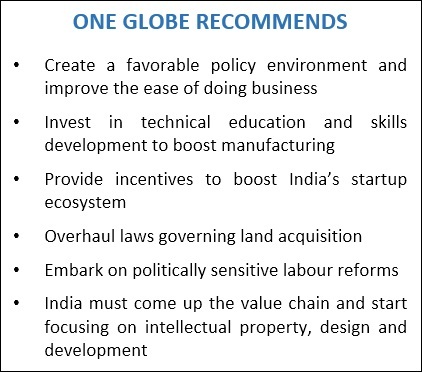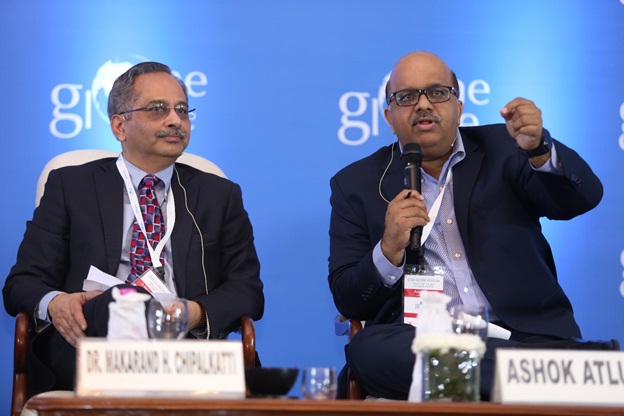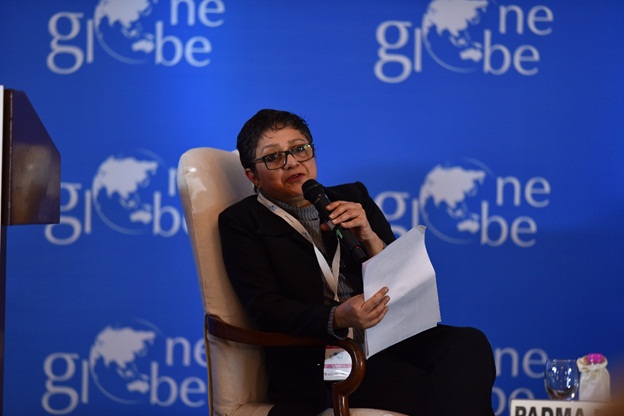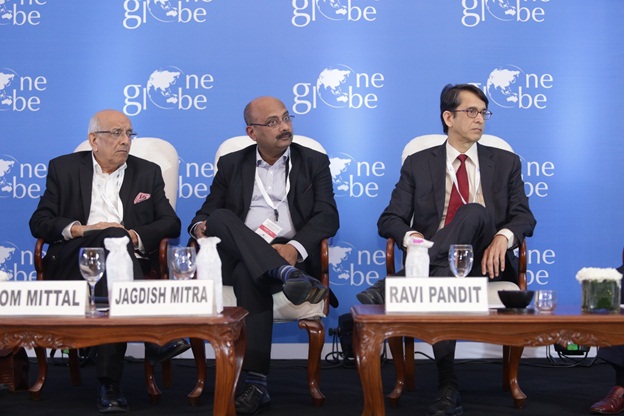How to build a 'Make in India' revolution with new Industries, rebooting IT and investment
Posted by Admin on December 11, 2017
 |
The 2017 edition of the One Globe Forum included several sessions that brought together top-level experts from diverse fields to discuss how to build a “Make in India” revolution. Mahendra Bapna, Senior Advisor, IIT-Jodhpur, moderated a panel titled “Make in India — Creating a 100 Million Jobs by 2022”, and kicked off the discussion by framing the challenges and opportunities. “With 100 million young people joining the workforce over the next decade, India has no choice but to transform into a manufacturing hub to create jobs and benefit from its demographic dividend,” said Mr Bapna, while listing the defense, electronics, construction, pharmaceuticals and healthcare industries as “priority areas” from a manufacturing perspective.
Mr Bapna observed that for manufacturing to take off, India needs to “move beyond rhetoric and create a clear strategy and favorable policy environment and improve the ease of doing business.” He listed five important steps for the government: stop “tax terrorism,” improve infrastructure, reform labor laws, invest in technology education and skills development, and ease land acquisition.
Building on this, panelist Dr C.V.R. Murty, Director, IIT - Jodhpur, pointed out that a strong technical education system is an absolute imperative to boost manufacturing. “It needs to be run professionally and has to be student-centric and outcome-based, and not the current faculty-centric model,” said Dr Murty. “You need a strong technical education system that can address the talent required to build urban centers and India’s infrastructure. We need to focus on competence building as a nation.”
Startups That Can Stand Up
Fellow panelist, Dr Makarand Chipalkatti, Managing Director, Dr Chips Consulting LLC, said electronics startups could be a “force multiplier” in creating well-paying jobs as every industry requires electronics from TV makers to computer manufacturers. “As an engineer, I look at the numbers quite literally,” said Dr Chipalkatti. “We are looking at creating 100 million jobs by 2022, that is in five years. To create 100 million jobs, you need 100,000 factories employing 1,000 people each to get 100 million jobs.”

Dr. Makarand Chipalkatti and Mr. Ashok Atluri
On the other hand, Dr Chipalkatti said India could score jobs by focusing on what he described as the “Five-Five-Five Solution.” “If you think of 500 million people who are in the age group of 20 to 35, with a lot of entrepreneurial enegrgy and ambition. Even if 5% of them create a business or startup in electronics manufacturing, perhaps on the higher end of the pyramid, employing five people, you have 100 million well-paying jobs,” said Dr Chipalkatti.
Fellow panelist Ashok Atluri, Chairman & MD, of defense industry technology firm Zen Technologies, took a contrarian position. Citing the example of Apple’s iPhone, he pointed out that the value of the iPhone is in its design and development, and not in its manufacturing. “If we follow “Make in India” for more than five years we are doomed as a country. If you look at an iPhone the bill of materials is $200 and Foxconn makes a couple of dollars off that. It is sold for $650 and $450 is captured by Apple. The value of any intellectually intense product is in design and development,” said Mr Atluri. “Unless we move up the value chain and start focusing on design and development we are in trouble,” said Mr Atluri, warning that automation would cannibalize manufacturing jobs. “Our slogan should be ‘Design, Develop and Make in India’.”
Tech Reboot
The good news is that India knows how to make an innovation leap. Twenty years ago, the Indian tech sector created a new global industry from scratch when it invented business process outsourcing. With $150 billion in revenues, India’s IT services accounts for 10% of India’s GDP and 3.6 million jobs.

Ms. Padma Rao
Padma Rao, Managing Producer, Sourcing and Senior International Correspondent, WION TV, moderated a panel titled “Beyond IT Services — What Will Be India’s Next Global Industry” and kicked off the discussion by asking if the IT industry’s global success is a template that can be replicated while exploring the government’s ‘Make in India’ initiative.
Som Mittal, former president and chairman of NASSCOM, stressed that India’s IT industry would continue to play a key role, but needed to rethink its business model. “When you ask what will be India’s next global industry? I have a real problem as we are not done with IT! Everything is about technology right now,” said Mr Mittal. “There’s only one pitfall: If we stick to the same models that made us successful earlier, we will be in big trouble.”
Building on this, fellow panelist Jagdish Mitra, Chief Strategy & Marketing Officer, Tech Mahindra, pointed out that with technology being all pervasive, there is a paradigm shift in the way clients are buying IT services. “The biggest challenge is that the buyers have changed. We no longer sell to the CIOs and the CTOs of the world. We now talk to chief marketing officers and so on. This requires a completely different strategy and skills.” He added that the Indian IT services industry needed to overhaul its brand positioning: “Our current brand positioning is one of being execution-oriented. We are seen as being good at following instructions. We need to change this. We need to position ourselves as problem solvers, as people who can predict the future,” said Mr Mitra.

Mr. Som Mittal, Mr. Jagdish Mitra, and Mr. Ravi Pandit
Software is Eating the World
Ashok Trivedi, Managing Partner, SWAT Capital, pointed out that the low-cost advantage is not sustainable when processes can easily migrate from India to Vietnam — or sometimes back to the US. “The H-1B scare could be a blessing in disguise for Indian IT companies. They are so well capitalized that they can create software products and build technology platforms to transform the IT industry,” said Mr Trivedi, adding that the Indian services industry has to reinvent itself through innovation and create new value. “The bigger IT companies now can afford to invest in innovation, and they are doing it,” he added.
Mr Trivedi observed that in the next 20 years there will be more innovation than in the last hundred years. “There are many new technologies that are on the cusp of becoming great industries: biotechnology, genomics, bioinformatics and biomedical engineering,” said Mr Trivedi. “India has a unique advantage in knowledge based industries. India already has a tremendous capacity for IT so the new activity will be in the intersection of Big Data, IT and biosciences,” he added.
Fellow panelist Ravi Pandit, Co-founder, Chairman and Group CEO, KPIT Technologies, stressed that we are in middle of a broad technological and economic shift in which software companies are poised to take over large swathes of the economy.
“The automotive and energy industries are going to be extremely dependant on information technology. As Marc Andreessen has said ‘software is eating the world’ which means that the technology component in every industry is changing and growing,” said Mr Pandit.
Marc Andreessen penned his famous essay titled “Why Software Is Eating the World” in “The Wall Street Journal” six years ago, where he predicted that many industries would be disrupted by software, with new world-beating tech companies doing the disruption.
“The Indian IT industry caught the wave at the right time, at the right place, but the time of the IT industry is not done. We are the start of another giant wave which includes new digital technologies, Internet of Things, Cloud, social media and AI. We will ride this new wave too,” said Mr Pandit.
Investing in India
Aashish Kalra, Chairman, Cambridge Technology Enterprises, moderated a panel titled “Investing in India — A Global Perspective” and kicked off the discussion by asking what India could do to attract investments. “The services industry is very mature, while manufacturing is still coming up the curb. There’s a fair amount of interest in India both from a sourcing angle and also as a customer destination for many companies. The ease of doing business is crucial to the success of ‘Make in India’,” said Amit Sethi, Former Managing Director, TSYS.
“The thing that bothers companies a lot is bureaucracy and the Indian bankruptcy laws which are not so robust,” said Mr Sethi. On the “Make in India” panel, Dr Makarand Chipalkatti also highlighted that it is critical to have strong bankruptcy laws and improve the ease of starting and closing a business. “This helps to de-risk decisions and results in faster setting up of manufacturing units,” said Dr Chipalkatti.
Foreign direct investment (FDI) inflows into India in 2016 jumped 18% to a record $46.4 on the back of the “Make in India” initiative, reported the Department of Industrial Policy and Promotion (DIPP). As part of their internationalization, Indian companies have also been buying up global brands. Fellow panelist, Patrick Santillo, Minister, Counselor for Commercial Affairs, US Embassy in New Delhi, acknowledged that India is “one of the fastest growing” FDI sources for the US. “India was the ninth-fastest growing foreign direct investor into the US in 2016. The total stock of FDI from India to the US now is about $19.3 billion,” said Mr Santillo. “We are interested in seeing this figure grow as much as India is interested in seeing the figure grow into India, so we get it,” he added.
Vikram Chachra, COO & Managing Partner, Eight Capital LLC, pointed out that in recent years, Amazon, Facebook, and Uber have announced ambitious plans and rapid rollouts in India as the county becomes their fastest growing market. “India provides the second largest user base for Facebook, WhatsApp, LinkedIn. India is also the largest market for Uber after the US. If I calculate the value of these companies ex-Apple it will be about a trillion dollars. We account for about $200 billion of your market capitalization. These are users that can start spending as we go higher. That is a very good reason to be doing FDI into India,” said Mr Chachra. Amazon is investing $5 billion in its operations in India, while Uber is investing more than $1 billion into the country.
Make for India
The goal of “Make in India” should not be to make India the next manufacturing workshop of the world. Rather, companies can create an advantage by making in India, for India. “India is an internal demand led economy and that is a huge advantage,” said Mr Kalra.
India’s “demographic dividend” is well known; more than 60% of its 1.33 billion population is in the working age group of 15-59 years and more than half of all Indians are under 25. India’s young tech savvy population likes to spend, provided it is offered the right products at the right prices. “We are creating a large consumer service economy and that is only going to grow bigger and bigger,” said Mr Kalra. The Boston Consulting Group (BCG) said in a report titled “The New Indian” that the country will be the third largest consumer market in the world by 2025. Almost 60% of Indian GDP is made up of domestic consumption, making India more like America than its export-oriented East Asian neighbors. Indians are no longer as fascinated as they once were with foreign goods and are willing to pay for Made in India.








